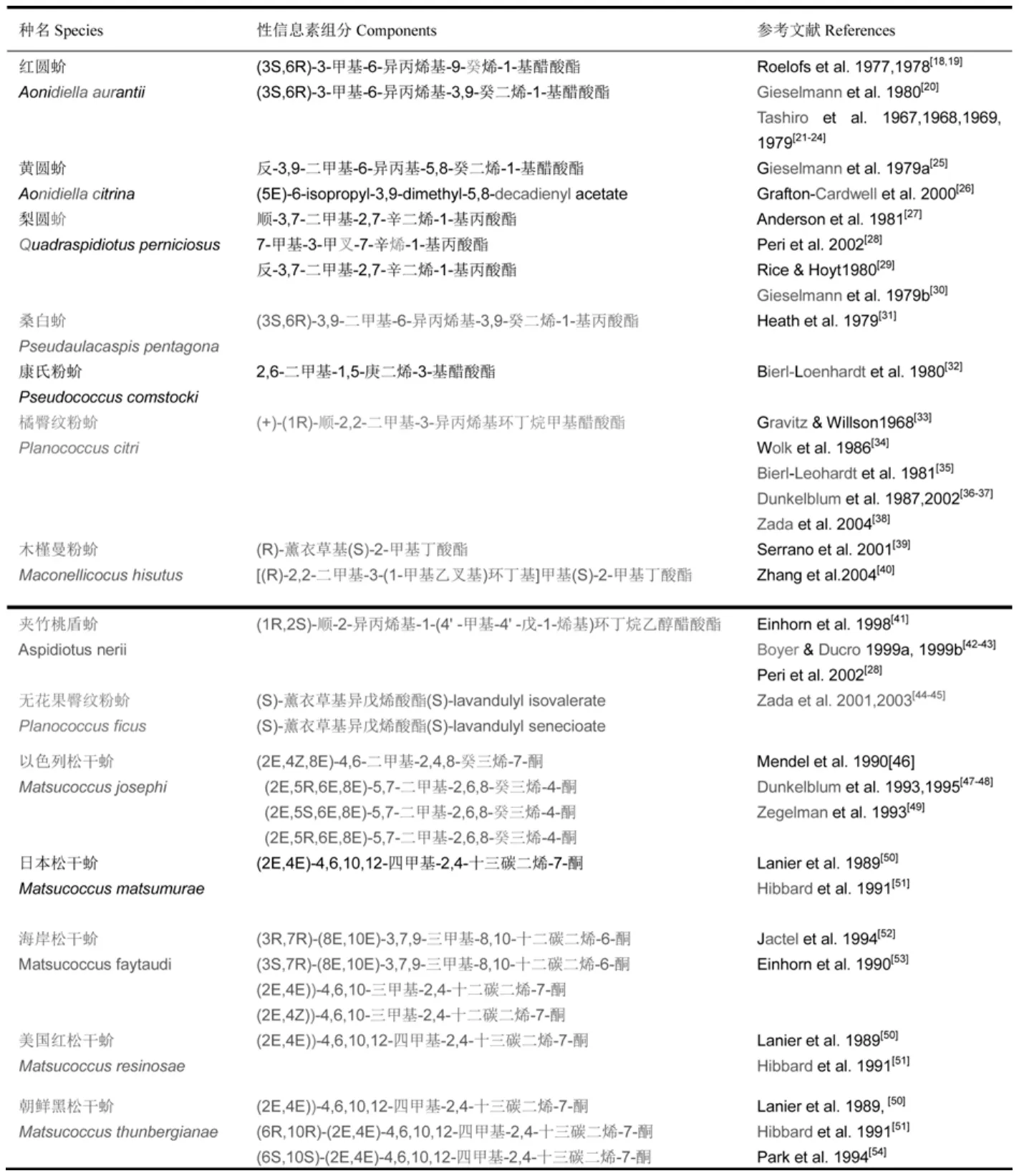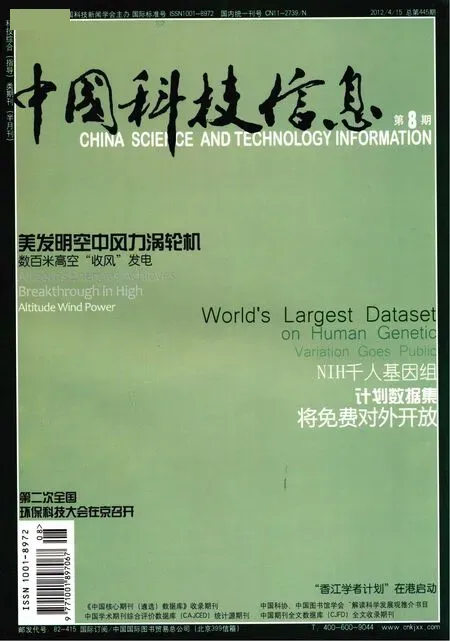介壳虫的生物防治研究进展
2012-10-27熊忠平
熊忠平
西南林业大学林学院,云南省森林灾害预警与控制重点实验室,云南 昆明 650224
介壳虫的生物防治研究进展
熊忠平
西南林业大学林学院,云南省森林灾害预警与控制重点实验室,云南 昆明 650224
本文介绍了寄生性天敌、捕食性天敌、致病菌及其代谢产物、性信息素等在介壳虫生物防治中的应用及进展。
介壳虫;性信息素;天敌
coccids; sex pheromone; natural enemy
介壳虫是同翅目,蚧亚目昆虫的统称,是园林、花卉、林木上发生较普遍且为害严重的害虫之一。其种类繁多,多数种类为害植物的枝干及叶、叶柄、果实、果柄等地上部分,少数为害根、块根、块茎等地下部分。其体外包着一般药剂难于透过的蜡壳、蜡粉、蜡丝等,因此给防治带来了极大的困难,在对其防治上,主要以生物防治方法为主。
1.介壳虫的研究历史及现状
关于蚧虫的研究,最早是从利用它作为资源开始的。早期对于蚧虫本身的认识一直模糊不清,有认为是 “Coccus”(古希腊文“浆果”之意),有认为是 “Kermes”(阿拉伯文“植物组织的瘤”),直到1781年J.Kerr才认出它是昆虫。对介壳虫的研究是从1758年林奈的《Systema Naturae》第十版一书为起点,之后的200年间V.Signoret, A.Targioni-Tozzetti,K.Sulc, A.D.MacGillivray, G.F.Ferris,Alex.Balachowsky, M.Kosztarab,D.R.Miller, J.O.Howell, A.B.Hamon等先后对蚧虫的分类学、组织学、蚧虫背腹半分图绘制、初孵若虫等方面做了深入系统研究,并出版了《世界蚧虫名录》(M.E.Fernald,1903, 1915)、《The Coccidae》(A.D.MacGillivray,1921)、《北美蚧虫图册》(G.F.Ferris,1937-1955)以及收集整理世界蚧虫研究的重要文献目录和文献集锦供国际上共同使用[1]。
我国的蚧虫研究历史悠久,利用蚧虫资源的文字记载可以追溯到唐代。但仅局限在利用方面的研究,关于其他方面的研究20世纪50年代之前大多是由国外蚧虫专家在我国进行的。我国的科学家从事蚧虫研究工作最早的是南京前中央大学农学院张景欧,他在1929年发表了我国蚧虫名录6亚科61种,加之后来季士俨、陈方洁、胡经甫的研究开创了我国自主研究蚧虫的新局面。
近几年,我国对于为害园林植物树种、森林树种、果树、农作物、药材与观赏植物的介壳虫研究取得了丰硕成果[2]。《中国农区的介壳虫》[3]、《中国蚧虫分类概要》[1]、《常见介壳虫鉴定手册》[4]、《中国盾蚧志(第一、二、三卷)》[5-7]、《中国蚧科》[8]、《中国经济昆虫志蚧总科》[9]、《中国动物志》(昆虫纲第二十二卷)[10]等系统地介绍了蚧总科分类系统的分类地位、蚧虫、分类形态特征、地理分布、蚧虫图绘制、经济意义等。
据N.S.Borchsenius于1958年统计,全世界已经发表的蚧虫有4445种。1979年全世界已经发表的蚧虫种类已达6000种以上。从1868年V.Signoret最初所列329种,到1903年M.Fernald列出1514种,和本世纪五十年代以来的数字相比,可以看到蚧虫研究发展迅速,近期尤为显著。我国过去虽有国外专家几次前来调查采集,但记载种类还不足650种[8,11]。近年来我国各地发表的蚧虫种类已开始有较大的增长。武三安2009年对我国大陆的有害蚧虫做了全面汇总:在我国大陆16科249属830种蚧虫中,有害蚧虫有13科84属211种,其中旌蚧科Ortheziidae 1属1种,珠蚧科Margarodidae 4属13种,绵蚧科Monophlebidae 3属6种,粉蚧科Pseudococcidae 19属40种,毡蚧科Eriococcidae 3属11种,胶蚧科Lacciferidae 2属3种,红蚧科Kermesidae 2属6种,链蚧科Asterolecaniidae 4属7种,壶蚧科Cerococcidae 2属4种,球链蚧科Lecaniodiaspidae 2属2种,蚧科Coccidae 16属36种,仁蚧科Aclerdidae 1属1种,盾蚧科Diaspididae 25属81种[12]。
2.介壳虫的生物防治
对介壳虫来说,因其个体很小或微小,不活泼或不能活动,且被有蜡层,物理、机械和化学的防治方法,代价昂贵而又不能达到目的,防治的最好途径是借助于天敌。由于天敌对害虫有预防和持续控制的价值,所以生物防治法在介壳虫系统防治措施中给予高度的重视与应用。生物防治大体上可以分为寄生性天敌、捕食性天敌和致病微生物及其代谢产物三大类。
2.1 寄生性天敌资源
介壳虫的寄生性天敌以膜翅目Hymenoptera种类为主,包括: 膜翅目的跳小蜂科Encyrtidae,蚜小蜂科Aphelinidae,啮小蜂科Tetrastichinae,柄翅小蜂科Mymaridae,金小蜂科Pteromalidae,姬小蜂科EuloPhidae,细蜂科Serphidae和蚁科Formicidae等,有50余属、200种左右。其中跳小蜂科和蚜小蜂科的种类最多,在介壳虫的寄生性天敌昆虫中占主导地位。
膜翅目寄生性天敌常见的优势种有:粉蚧长索跳小蜂Anagyrus dectylopii(寄主为堆蜡粉蚧)、盾蚧长缨蚜小蜂Aspidiotophagus citrinus(寄主为黑点蚧)、蚜小蜂Aphytis yanonensis(寄主为矢尖蚧)、花角蚜小蜂Physcus falyus(寄主为矢尖蚧)、红帽蜡蚧扁角跳小蜂Anicetus ohgushii(寄主为蜡蚧)、黄金蚜小蜂A.chrysompholi(寄主为矢尖蚧、红圆蚧、黄圆蚧、橙褐圆)、印巴黄蚜小蜂 Aphytis melinus(寄主为柑桔红圆蚧)、褐黄异角蚜小蜂Coccobius fulvus(寄主为矢尖蚧)、松突圆蚧花角蚜小蜂C. azumai(寄主为松突圆蚧)、友恩蚜小蜂Encarsia amicula(寄主为松突圆蚧)、球蚧蓝绿跳小蜂Blastothrix sericae(寄主为球坚蚧)、黑色食蚧蚜小蜂Coccophagus yoshidae(寄主为球蚧和枣球蜡蚧)等[13]。
介壳虫的寄生性天敌还包括双翅目寄生蝇的一些种类。比如寄生在绵蚧上的潜蝇科Agromyzidae蚧潜蝇属Cryptochaetum的种类。
2.2 捕食性天敌资源
介壳虫的捕食性天敌主要包括鞘翅目Coleoptera、脉翅目Neuroptera、双翅目Diptera、缨翅目Thysanoptera及螨类Acarina中的种类。
在介壳虫的捕食性天敌中,最值得注意的是瓢虫科Coccinellidae种类。澳洲瓢虫(Rodolia cardinalis)防治吹绵蚧(Icerya purchasi)已成为生物防治的最精彩和辉煌篇章为世人所熟知,现已经在亚、非、欧、南美洲的50多个国家成功应用。另外还包括红瓢虫属Rodalia、隐唇瓢虫属Cryptolaemus、盔唇瓢虫属Cilocorus、寡节瓢虫属Telsimia等的100余种类被成功的广泛应用。常见种类有盂氏隐唇瓢虫C. montrouzieri、蒙古光瓢虫Brumus mongol、红点唇瓢虫Chilocorus kuwanae、红环瓢虫Rodolia limbata、黑缘红瓢虫C. rubidus等(Zhou, 1982)。
捕食介壳虫的鞘翅目昆虫,除瓢虫外,包括长角象甲科Antribidae的花斑长角象甲Antribus fasciatus,方头甲科中的日本方头甲Cybocephalus nipponicus等种类。
脉翅目的天敌,主要是草蛉科Chrysopidae草蛉属Chrysopa,褐蛉科Hemerobiidae毛褐蛉属Symphaerobius,粉蛉科Coniopterygidae粉蛉属Coniopteryx和重粉蛉属Semidalis等种类。成虫和幼虫均能捕食介壳虫、蚜虫、叶蝉、木虱及蛾蝶类小幼虫和多种昆虫的卵,食量较大,是果园中的重要天敌。常见的有大草蛉C. septempunctata、牯岭草蛉C.kulingensis、中华草蛉C. sinica、丽草蛉C. formosa、全北褐蛉Hemerobius humuli和松蚧益蛉S. matsucocciphagus等(Zhou,1982)[6]。
双翅目捕食介壳虫的种类,著名的是潜蝇科Agromyziae丘蝇属Leucopis的—些种。瘿蚊科Ceccidomyiidae的Lobodiplosis,Coccidiplosisi,Diplosisi等属的某些种和食蚜蝇科Syrphidae的某些种(Zhou, 1982)[6]。
鳞翅目中,夜蛾科Noctuidae食蚧夜蛾Eublemma scitula是最负盛名的一种,还包括举肢蛾科的北京举肢蛾Beijinga utila,遮颜蛾科Blastobasidae的一些种类,以幼虫吃介壳虫的卵和若虫。
半翅目的包括猎蝽科Reduviidae、花蝽科Anthocoridae。常见的是松干蚧花蝽Elatophilus japonensis、黑脂猎蝽Velinus nodipes等。
螳螂目的主要是螳螂科Mantidae,常见种类有中华大刀螳螂Tenodera aridlfolia、广腹螳螂Hierodula palellifera等。
缨翅目的管蓟马科Phlaeothripidae。
捕食性的膜翅目昆虫,有短腹小蜂科Tridyidae的盾背小蜂Scutellista cyanea和网目蚧小蜂Anysis saissetiae(Zhou, 1982)[6]。
2.3 致病菌及其代谢产物研究
介壳虫的细菌性和真菌性病也是很普通的,有利用的可能,但对它的研究,目前也是很不充分的。
国内外在致病菌及其代谢产物用于介壳虫防治上,也主要集中在对白僵菌Beauveria bassiana、绿僵菌Metarhizium anisopliae、苏云金杆菌Bacillus thuringiensis、蜡蚧轮枝菌Verticillium lecanii等的理论和实际应用研究。如苏云金杆菌防日本松干蚧(Matsucoccns matsumurae)在南京、杭州、无锡等地进行了系列综合防治试验;乳菇轮枝孢菌Verticillium lecanii分布于热带、亚热带地区,寄主范围极广,能引起30%~95%的咖啡绿蚧死亡[14-16]。
3 介壳虫性信息在生物防治上的应用
3.1 介壳虫性信息的组成成分
现已有10多种介壳虫性信息素化学结构被鉴定出 (表1)。
介壳虫性信息素具有以下特点:蚧虫性信息素化学结构简单,但特异性强,稍微改变一下化学结构就会造成引诱活性的大幅度降低;不同种类的蚧虫使用相同的性信息素,利用地理位置或季节差别达到种间隔离;以酮或有机酸酯作为性信息素[17]。
3.2 性信息素在介壳虫测报上的应用
利用性信息素监测预报害虫是性信息素应用的重要内容之一。目前有关性信息素在介壳虫测报中应用的实例还很少。仅见用红圆蚧未交配雌成虫与粘胶板组成性信息素诱捕器来统计危害,梨圆蚧性信息素观察分布为害地区及发生消长状况,日本松干蚧的种类调查等的报道[55,14]。
3.3 性信息素在介壳虫防治上的应用
性信息素在害虫防治上主要是大量诱杀技术和交配干扰技术的应用。目前,该诱杀技术防治蚧虫的报道也还处于试验研究阶段,应用及报道比较少,仅见在日本松干蚧、红圆蚧上的研究[56,57]。
4.讨论
介壳虫的生物防治包括寄生性天敌、捕食性天敌、致病菌及产物在控制介壳虫虫口密度上的应用,同时还包括利用介壳虫本身性激素来预防及控制等方面。
对于介壳虫天敌种类的调查已经取得了丰硕的成果,并且还在不断有新种被发现。但具有应用价值的还很少,工厂化生产的尚未见报道。而且是选择专化性强的,还是选择控制范围广的种类进行推广应用,也需进一步深入的研究确定,专化性强的种类,控制力强,但应用成本高,选择控制范围广的种类控制力又是一个必须面对的问题。
利用病原菌及产物和性信息素防治介壳虫的研究还处于初步的试验阶段。其中对优势控制菌株的发掘和保护也是一项值得重视的工作。另外,关于性信息素方面的研究,还存在对目标昆虫性信息素结构的鉴定是否准确和完全,诱芯的形状、颜色、设置位置,诱芯中性信息素的浓度、各组分的配比,气候条件,虫口密度和昆虫的迁飞等的问题。
虽然,生物防治方法在介壳虫危害控制中运用取得了很多成果,但是面对目前日益猖獗的介壳虫危害形势,要真正发挥生物防治的效益还需要加强对介壳虫天敌资源调查、保护和开发等方面的研究,加强性信息素基础研究,加强介壳虫的综合防治管措施研究,使其更普遍、有效地得以推广和应用。

表1 蚧虫性信息素
[1]杨平澜.中国蚧虫分类纲要[M].上海科学技术出版社, 1982,425.
[2]汤德.我国蚧虫研究的历史、现状和展望[J].武夷科学,2001,17(12):82~86.
[3]王子清.中国农区的介壳虫[M].北京:中国农业出版社, 1982.
[4]王子清.常见介壳虫鉴定手册[M]. 北京:科学出版社, 1985.
[5]周尧.中国盾蚧(第一卷)[M].陕西:陕西科学技术出版社,1982,195.
[6]周尧.中国盾蚧(第二卷)[M].陕西:陕西科学技术出版社,1985,296.
[7]周尧.中国盾蚧(第三卷)[M].陕西:陕西科学技术出版社,1986,281.
[8]汤邡德.中国蚧科[M].山西高校联合出版社,1991,377.
[9]王子清.中国经济昆虫志第四十三册同翅目蚧总科[M].北京:北京科学出版社,1994, 294.
[10]王子清.中国动物志.昆虫纲.第二十二卷.同翅目:蚧总科:粉蚧科、绒蚧科、蜡蚧科、链蚧科、盘蚧科、壶蚧科、仁蚧科 [M]. 北京:科学出版社,2001.
[11]陶家驹.中国介壳虫总科名录[M].台湾农业试验所,1999,76.
[12]武三安.中国大陆有害蚧虫名录及组成成分分析(半翅目:蚧总科)[J].北京林业大学学报,2009,(4).55~63.
[13]吴国艳.中国北方介壳虫寄生蜂分类区系研究[D].杭州:浙江大学,2002,1~10.
[14]周琳,李锦辉,房付林,等.介壳虫性信息素研究进展[J]. 河南林业科技,1999,19(4):11~15.
[15]刘昌芬. 咖啡蚧虫的生物防治和云南咖啡害虫综合治理浅见[J].云南热作科技,1997,20(4):20~23
[16]何衍彪,詹儒林,赵艳龙.蚧虫预测预报及综合防治[J].安徽农业科学,2007,35(13):3895~3897.
[17]董文霞,韩宝瑜.蚧虫化学生态学研究进展[J].生态学报,2005,25(4): 878~894.
[18]Roelofs WL, Gieselmann M, Cardé A. Sex pheromone of red scale,Anoidiella aurantiii[J].Nature. 1977,267:698~699.
[19]Roelofs WL, Gieselmann M, Cardé A. Identification of the California red scale sex pheromone[J]. J Chem Ecol.4(2): 1978,211~224.
[20]Gieselmann MJ, Henrick CA, Anderson RJ, et al.Responses of male California red scale to sex pheromone isomers[J]. J Insect Physiol. 1980,26(3):179~182.
[21]Tashiro H, Chambers DL. Reproduction in the California red scaleAnoidiella aurantiii(Homoptera: Diaspididae)Ⅰ. Discoveryand extraction of a female sex pheromone[J]. Ann Entomol Soc Am . 1967,60:1166.
[22]Tashiro H, Moffitt C. Reproduction in the California red scale,Anoidiella aurantiii Ⅱ. Mating behavior and postinsemination changes[J]. Ann Entomol Soc Am . 1968,61:1014.
[23]Tashiro H, Beavers JB, Moreno D. Comparative response of two strains of California red scale,Anoidiella aurantiii, males topheromone extract and to females of the reciprocal strain[J]. Ann Entomol Soc Am . 1969,62:279.
[24]Tashiro H, Gieselmann MJ, Roelofs WL. Residual activity of a California red scale synthetic pheromone component [J]. Envir Entomol.1979,.8: 931~934.
[25]Gieselmann MJ, Moreno DS, Fargerlund J, et al.Identification of the sex pheromone of the yellow scale[J]. J Chem Ecol. 1979, 5(1): 27~33.
[26]Grafton-Cardwell EE, Millar JG, O'Connell NV. Sex pheromone of yellow scale, Aonidiella citrina(Homoptera: Diaspididae):Evaluation as an IPM tactic[J]. J Agr Urban Entomol. 2000,17:75~88.
[27]Anderson RJ, Gieselmann MJ, Chinn HR, et al.Synthesis and identification of a third component of the San Jose scale sex pheromone[J]. J Chem Ecol. 1981,7(4):695~706.
[28]Peri E, Colazza S, Saiano F. Females sex pheromone of its production and release[J].IOBC/WPRC Bulletin. 2002,25:1~5.
[29]Rice RE , Hoyt SC. Response of San Jose scale to natural and synthetic sex pheromones[J].Envir Entomol. 1980,9:190~194.
[30]Gieselmann MJ, Rice RE, Jones RA. Sex pheromone of the San Jose scale[J]. J Chem Ecol. 1979,5(6):891~900.
[31]Heath RR, McLaughlin JR, Tumlinson JH. Identification of the white peach scale sex pheromone: an illustration of microtechniques[J]. J Chem Ecol. 1979,5(6): 941~953.
[32]Bierl-Leonhardt BA, Moreno DS, Schwarz M, et al. Identification of the pheromone of the Comstock mealybug[J].L Sci. 1980,27(5):399~402.
[33]Gravitz N, Willson C. A sex pheromone from the citrus mealybug[J]. J Econ Entomol. 1968,61:1458.
[34]Wolk JL, Goldschmidt Z, Dunkelblum E. A short stereoselective synthesis of (+)-cisplanococcyl acetate, sex pheromone of the citrusmealybug Planococcus citri(Risso) [J]. Synthesis. 1986,347~348.
[35]Bierl-Leonhardt BA, Moreno DS, Schwarz M, et al. Isolation, identification, and synthesis of the sex pheromone of the citrusmealybug,Planococcus citris(Risso) [J]. Tetrahedron Lett. 1981,22(5):389~392.
[36]Dunkelblum E, Ben-Dov J, Goldschmidt Z, et al. Synthesis and field bioassay of some analogs of sex pheromone of citrus mealybug,Planococcus citri(Risso) [J]. J Chem Ecol. 1987,13(4):863~871.
[37]Dunkelblum E, Zada A, Gross S, et al.Sex pheromone and analogs of the citrus mealybug, Planococcus citri: synthesis and biologicalactivity[J]. IOBC wprs Bulletin. 2002, 25: 1~9.
[38]Zada A, Dunkelblum E, Harel M . Sex pheromone of the citrus mealybugPlanococcus citri: synthesis and optimization of trapparameters[J]. J Econ Entomol. 2004,97(2): 361~368.
[39]Serrano MS, Lapointe SL, Meyerdirk DE. Attraction of Males by Virgin Females of the MealybugMaconellicoccus hirsutus(Hemiptera: Pseudococcidae) [J]. Envir Entomol. 2001,30(2): 339~345.
[40]Zhang A, Amalin D, Shirali S. Sex pheromone of the pink hibiscus mealybug, Maconellicoccus hirsutus, contains an unusualcyclobutanoid monoterpene[J]. PNAS. 2004,101(26):9601~9606.
[41]Einhorn J, Guerrero A, Ducrot P H, et al. Sex pheromone of the oleander scale,Aspidiotus nerri: Structural characterization andabsolute configuration of an unusual[J]. PNAS. 1998,95(17): 9867~9872.
[42]Boyer FD , Ducrot PH. Syntheses of Cyclobutane Derivatives: Total Synthesis of (+) and (-) eantiomers of the oleander scale Aspidiotus neriisex pheromone[J]. EurR J Org Chem. 1999,5: 1201~1211.
[43]Boyer FD , Ducrot PH. Total synthesis of the enantiomers of Aspidiotus nerii sex pheromone[J]. CR ACAD SCI II C. 1999,2(1): 29~33.
[44]Zada A, Dunkelblum E, Assael F. Identification of a second sex pheromone component of the vine mealybug[J]. Boll di Zool Agr e di Bachicoltura. 2001,33(3): 275~281.
[45]Zada A, Dunkelblum E, Assael F,et al. Sex pheromone of the vine mealybug,Planococcus ficusin Israel: occurrence of a second component in a massreared population[J].J J Chem Ecol.. 2003,29(4): 977~988.
[46]Mendel Z, Dunkelblum E, Robison D. Sexual behavior ofMatsucoccus josephi(Homoptera: Margarodidae) asynchronous adult male emergence and release of female sex pheromone[J]. J Chem Ecol. 1990,16: 2341~2352.
[47]Dunkelblum E, Mendel Z, Assael F, et al.Identification of the female sex pheromone of the Israeli pine bast scale Matsucoccus josephi[J]. Tetrahedron Lett. 1993, 34(17): 2805~2808.
[48]Dunkelblum E, Gries R, Gries G, et al. Chirality of Israeli pine bast scale,Matsucoccus josephi(Homoptera: Matsucoccidae) sex pheromone[J]. J Chem Ecol. 1995,21(6): 849~853.
[49]Zegelman L, Hassner A, Mendel Zl. Synthesis and field bioassay of the Israeli pine bast scale,Matsucoccus josephi, female sex pheromone[J]. IOBC/WPRC Bulletin. 1993,34:5641~5644.
[50]Lanier GN, Qi YT, West JR. Identification of the sex pheromone of three Matsucoccus pine bast scales[J]. J Chem Ecol. 1989,15: 1645~1659.
[51]Hibbard BE, Lanier GN, Parks SC. Laboratory and field tests with the synthetic sex pheromone of three Matsucoccus pine bast scales[J]. J Chem Ecol. 1991,17: 89~102.
[52]Jactel H, Menassieu P, Lettere M. Field response of maritime pine scale,Matsucoccus feytaudi Duc. ( Homoptera:Margarodidae), to synthetic sex pheromone stereoisomers[J]. J Chem Ecol. 1994,20:2159~2170.
[53]Einhorn J, Menassieu P, Malosse C, et al. Identification of the sex pheromone of the maritime pine scale,Matsucoccus feytaudi[J]. Tetrahedron Lett. 1990,46(31): 6633~6636.
[54]Park SC, Wi AJ, Kim HS. Response of Matsucoccus thunbergianae males to synthetic sex pheromone and its utilization for monitoring the spread to infestation[J]. J Chem Ecol. 1994,20:2185~2196.
[55]祁云台,杨牡丹,赵方桂.日本松干蚧性信息素研究初报[J].昆虫学研究集刊,1983,(3):21~23.
[56]祁云台,符文俊,许少甫,等.日本松干蚧雄虫对天然性信息素的反应剂量及林间诱捕试验[J].昆虫学研究集刊,1985,(5):13~17.
[57] 韩桂彪.昆虫性信息素交配干扰技术研究进展[J].森林病虫通讯,1996,(1):32~34.
Biological control of coccids (Homoptera,Coccomorpha)
XIONG Zhong-Ping
(faculty of forestry Southwest Forestry University,Key Laboratory of Forest Disaster Warning and Control, Kunming Yunnan 650224, China)
History and advances in the researches of predator,parasite,pathogen,metabolite of pathogen and sex pheromone of coccids were introduced.
10.3969/j.issn.1001-8972.2012.08.055
西南林业大学面上项目(110953);云南省重点学科建设项目(XKZ200905)
熊忠平(1979-),男,云南会泽人,实验师,硕士学位,主要从事森林保护学和实验室管理方面的研究。
